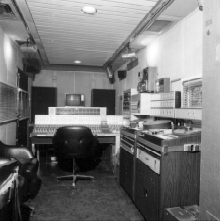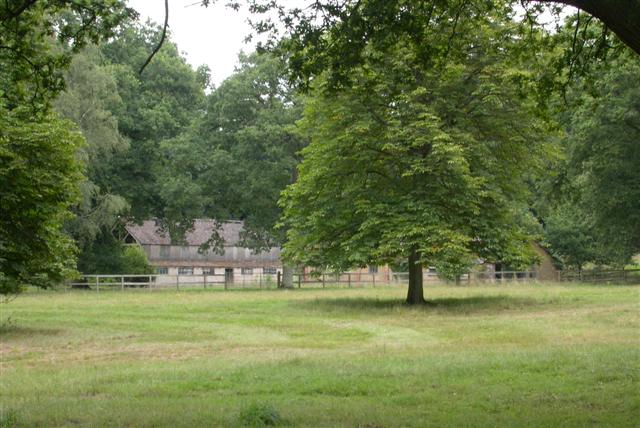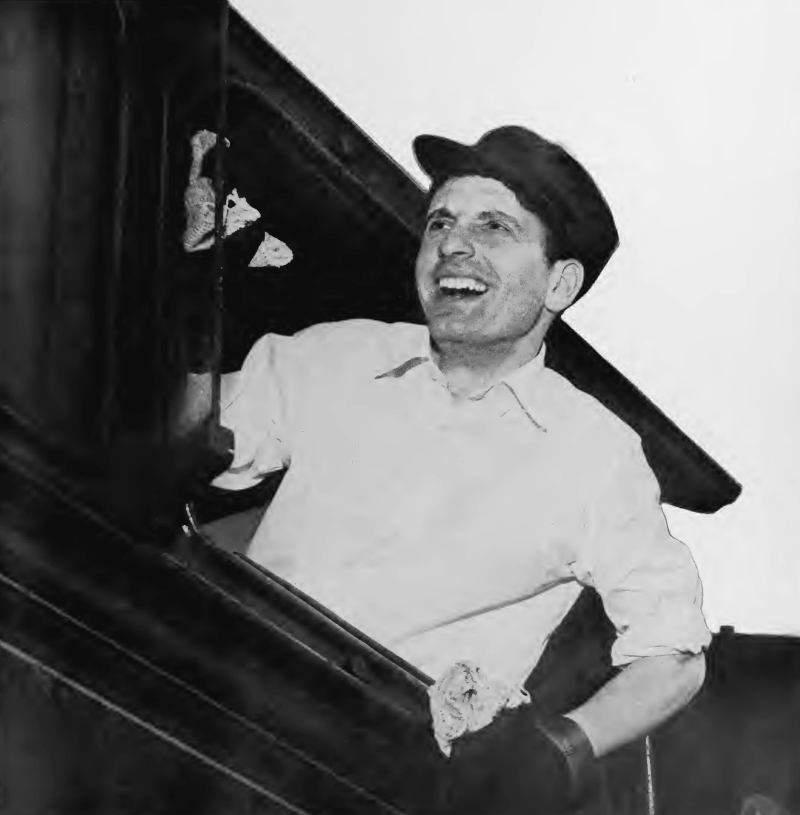|
Rolling Stones Mobile Studio
The Rolling Stones Mobile Studio (also known as the RSM) is a mobile recording studio inside a DAF F1600 Turbo truck, once owned by the English rock band The Rolling Stones. Numerous bands and artists have recorded music using the RSM, including The Who, Dire Straits, Deep Purple, Lou Reed, Bob Marley, Horslips, Nazareth, Fleetwood Mac, Bad Company, Status Quo, Led Zeppelin, Iron Maiden, Wishbone Ash, Motörhead and the Rolling Stones themselves. Today, the RSM resides at the National Music Centre in Calgary, where it remains a fully operational (though now stationary) recording studio. History The concept for the Rolling Stones Mobile Studio came about in 1968 when the Rolling Stones, tired of the 9-to-5 limitations of commercial recording studios and being billed for studio time sometimes spent rehearsing or composing, decided to find a way to record at Mick Jagger's new Stargroves country estate. Since recording at this residential location would require all of the necessa ... [...More Info...] [...Related Items...] OR: [Wikipedia] [Google] [Baidu] [Amazon] |
Recording Studio
A recording studio is a specialized facility for Sound recording and reproduction, recording and Audio mixing, mixing of instrumental or vocal musical performances, spoken words, and other sounds. They range in size from a small in-home project studio large enough to record a single singer-guitarist, to a large building with space for a full orchestra of 100 or more musicians. Ideally, both the Studio recording, recording and monitoring (listening and mixing) spaces are specially designed by an acoustician or audio engineer to achieve optimum acoustic properties (acoustic isolation or diffusion or absorption of reflected sound reverberation that could otherwise interfere with the sound heard by the listener). Recording studios may be used to record singers, instrumental musicians (e.g., electric guitar, piano, saxophone, or ensembles such as orchestras), voice-over artists for advertisements or Dubbing, dialogue replacement in film, television, or animation, Foley (filmmaking) ... [...More Info...] [...Related Items...] OR: [Wikipedia] [Google] [Baidu] [Amazon] |
Motörhead
Motörhead () were an English rock music, rock band formed in London in 1975 by bassist and lead vocalist Lemmy Kilmister, guitarist Larry Wallis and drummer Lucas Fox. Kilmister was the primary songwriter and only constant member. The band are often considered a precursor to the new wave of British heavy metal, which re-energised heavy metal music, heavy metal in the late 1970s and early 1980s. Though several guitarists and drummers have played in Motörhead, most of their best-selling albums and singles feature drummer Phil Taylor (musician), Phil "Philthy Animal" Taylor and guitarist "Fast" Eddie Clarke. From 1995 until the band's break-up in 2015, the group consisted of Kilmister, guitarist Phil Campbell (musician), Phil Campbell and drummer Mikkey Dee. Motörhead released 23 studio albums, 10 live recordings, 12 compilation albums and five EPs over a career spanning 40 years. Usually a power trio, they had particular success in the early 1980s with several successful sing ... [...More Info...] [...Related Items...] OR: [Wikipedia] [Google] [Baidu] [Amazon] |
Sticky Fingers
''Sticky Fingers'' is the ninth studio album by the English rock band the Rolling Stones. It was released on 23 April 1971 on the Rolling Stones' new label, Rolling Stones Records. The Rolling Stones had been contracted by Decca Records and London Records in the UK and the US since 1963. On this album, Mick Taylor made his second full-length appearance on a Rolling Stones album (after the live album '' Get Yer Ya-Ya's Out!''). It was the first studio album without Brian Jones, who had died two years earlier. The original Grammy-nominated cover artwork, conceived and photographed by Andy Warhol, showed a picture of a man in tight jeans, and had a working zip that opened to reveal underwear fabric. The cover was expensive to produce and damaged the vinyl record, so the size of the zipper adjustment was made by John Kosh at ABKCO Records. Later re-issues featured just the outer photograph of the jeans. The album featured a return to basics for the Rolling Stones. The u ... [...More Info...] [...Related Items...] OR: [Wikipedia] [Google] [Baidu] [Amazon] |
Led Zeppelin IV
The untitled fourth studio album by the English Rock music, rock band Led Zeppelin, commonly known as ''Led Zeppelin IV'', was released on 8 November 1971, by Atlantic Records. It was produced by the band's guitarist, Jimmy Page, and recorded between December 1970 and February 1971, mostly in the country house Headley Grange. The album contains one of the band's most well-known recordings, the eight-minute-long "Stairway to Heaven". The informal recording environment inspired the band, allowing them to try different arrangements of material and create songs in various styles. After the previous album ''Led Zeppelin III'' (1970) received lukewarm reviews from critics, they decided their fourth album would officially be untitled and represented instead by four symbols one chosen by each band member without featuring the name or any other details on the cover. Unlike the prior two albums, the band was joined by guest musicians: singer Sandy Denny on "The Battle of Evermore", and pia ... [...More Info...] [...Related Items...] OR: [Wikipedia] [Google] [Baidu] [Amazon] |
Led Zeppelin III
''Led Zeppelin III'' is the third studio album by the English rock band Led Zeppelin, released on 5 October 1970. It was recorded in three locations. Much of the work was done at Headley Grange, a country house, using the Rolling Stones Mobile Studio. Additional sessions were held at Island Studios and Olympic Studios in London. As with the prior album, the band eschewed the use of guest musicians, with all music performed by band members Robert Plant (vocals), Jimmy Page (guitars), John Paul Jones (bass, keyboards), and John Bonham (drums). The range of instruments played by the band was greatly enhanced on this album, with Jones especially emerging as a talented multi-instrumentalist, playing a wide range of keyboard and stringed instruments, including various synthesizers, mandolin and double bass, in addition to his usual bass guitar. As with prior albums, Page served as producer on the album, with mixing done by Andy Johns and Terry Manning. The album showed a progressi ... [...More Info...] [...Related Items...] OR: [Wikipedia] [Google] [Baidu] [Amazon] |
The Faces
Faces are an English rock band formed in London in 1969. They were formed by members of Small Faces after lead singer and guitarist Steve Marriott left to form Humble Pie. The remaining Small Faces; Ian McLagan (keyboards), Ronnie Lane (bass, vocals), and Kenney Jones (drums and percussion) were joined by guitarist Ronnie Wood and singer Rod Stewart, both from the Jeff Beck Group, and the new line-up was renamed Faces. The group had a unique arrangement, as Rod Stewart had signed a separate solo recording contract with the Mercury label shortly before joining the group, which was signed to Warner Bros. Band members often contributed to Stewart's solo albums as contract players, and Faces live shows of the period would feature as much of Stewart's solo material as that of the band, which later fuelled tensions amongst them when they began to effectively be viewed as Stewart's 'backing band'. The group lacked a single main songwriter as from the beginning each member would wo ... [...More Info...] [...Related Items...] OR: [Wikipedia] [Google] [Baidu] [Amazon] |
Helios (mixing Console)
Helios was a brand of mixing consoles custom-designed and built for use in recording studios. Produced from 1969 to 1979, Helios consoles were utilized by many key recording studios to produce numerous notable recordings and played a vital part in the history of British rock. History Background Richard "Dick" Swettenham was a British technician and engineer who was the Technical Director at Olympic Studios in the 1960s, where he designed and custom-built the studios' innovative wraparound mixing consoles. In 1968, when Island Records wanted a mixing console for the company's new Basing Street Studios, Glyn Johns persuaded Swettenham to leave Olympic Studios and partner with Island Records founder Chris Blackwell to start his own mixing console manufacturing company, and Helios Electronics was established in 1969. 10 years later, in 1979, Helios Electronics ceased operations. Helios founder Swettenham died of cancer on April 9, 2000. Console design Like their predecessors at Oly ... [...More Info...] [...Related Items...] OR: [Wikipedia] [Google] [Baidu] [Amazon] |
Glyn Johns
Glyn Thomas Johns (born 15 February 1942) is an English recording engineer and record producer. He has worked with many of the most famous rock recording acts from both the UK and abroad, such as the Rolling Stones, the Beatles, the Who, Led Zeppelin, the Kinks, Eagles, Bob Dylan, the Band, Eric Clapton, the Clash, Steve Miller Band, Small Faces, the Ozark Mountain Daredevils and Joan Armatrading. Throughout his career, he has generally preferred a live, natural approach to recording in the studio, and developed a method of recording drums sometimes referred to as the " Glyn Johns method". The years 1964–1984 marked Johns's peak era of activity in which he engineered or produced numerous hit records. In 1965 Johns became one of the first independent British recording engineers to operate freelance rather than under the hire of a particular record label or studio. He was involved in making some of the most influential albums of the rock era such as '' Beggars Banquet'' ... [...More Info...] [...Related Items...] OR: [Wikipedia] [Google] [Baidu] [Amazon] |
Ian Stewart (musician)
Ian Andrew Robert Stewart (18 July 1938 – 12 December 1985) was a British keyboardist and co-founder of the Rolling Stones. He was removed from the lineup in May 1963 at the request of manager Andrew Loog Oldham who felt he did not fit the band's image. He remained as road manager and pianist for over two decades until his death, and was posthumously inducted into the Rock and Roll Hall of Fame along with the rest of the band in 1989. Early life Stewart was born at his mother's family farm, Kirklatch, at Pittenweem, in the East Neuk of Fife, Scotland, and raised in Sutton, son of architect John Stewart and Annie, née Black. He attended Tiffin School, Kingston upon Thames, Greater London. Stewart (often called Stu) started playing piano when he was six. He took up the banjo and played with amateur groups on both instruments. Career Role in The Rolling Stones Stewart, who loved rhythm & blues, boogie-woogie, blues and big-band jazz, was working as a shipping clerk ... [...More Info...] [...Related Items...] OR: [Wikipedia] [Google] [Baidu] [Amazon] |
Stargroves
Stargroves (also known as Stargrove House) is a manor house and associated estate at East Woodhay in the English county of Hampshire. The house belonged to Mick Jagger during the 1970s and was a recording venue for the Rolling Stones and various other rock bands, as well as a filming location for ''Doctor Who''. History The Goddard family owned the estate from 1565 until about 1830. Oliver Cromwell stopped at Stargroves after the second battle of Newbury (27 October 1644), and was entertained by the owner, John Goddard. Edward Goddard owned the estate from 1778 to 1788. It was also owned by Capt. Sir F. H. W. Carden, 3rd Baronet. In the early 1840s, Stargrove House was destroyed by a fire. Around 1848 a new manor house was built, designed in an ornate, Victorian Gothic style in the manner of a French château. The new house was bought by a Captain Ramsay, and in 1879 was sold to Sir Frederick Henry Walter Carden, who made alterations to the house and landscaped the park. ... [...More Info...] [...Related Items...] OR: [Wikipedia] [Google] [Baidu] [Amazon] |
Mick Jagger
Sir Michael Philip Jagger (born 26 July 1943) is an English musician. He is known as the lead singer and one of the founder members of The Rolling Stones. Jagger has co-written most of the band's songs with lead guitarist Keith Richards; Jagger–Richards, their songwriting partnership is one of the most successful in rock music history. His career has spanned more than six decades, and he has been widely described as one of the most popular and influential front men in the history of rock music. His distinctive voice and energetic live performances, along with Richards' guitar style, have been the Rolling Stones' trademark throughout the band's career. Early in his career, Jagger gained notoriety for his romantic involvements and illicit drug use, and has often been portrayed as a counterculture, countercultural figure. Jagger was born and grew up in Dartford. He studied at the London School of Economics before abandoning his studies to focus on his career with the Rolling Sto ... [...More Info...] [...Related Items...] OR: [Wikipedia] [Google] [Baidu] [Amazon] |
Interior Pix 3
Interior may refer to: Arts and media * ''Interior'' (Degas) (also known as ''The Rape''), painting by Edgar Degas * ''Interior'' (play), 1895 play by Belgian playwright Maurice Maeterlinck * ''The Interior'' (novel), by Lisa See * Interior design, the trade of designing an architectural interior * ''The Interior'' (Presbyterian periodical), an American Presbyterian periodical * Interior architecture, process of designing building interiors or renovating existing home interiors Places * Interior, South Dakota * Interior, Washington * Interior Township, Michigan * British Columbia Interior, commonly known as "The Interior" Government agencies * Interior ministry, sometimes called the ministry of home affairs * United States Department of the Interior Other uses * Interior (topology), mathematical concept that includes, for example, the inside of a shape * Interior FC, a football team in Gambia See also * * * List of geographic interiors * Interiors (other) * ... [...More Info...] [...Related Items...] OR: [Wikipedia] [Google] [Baidu] [Amazon] |








